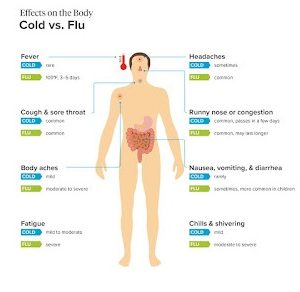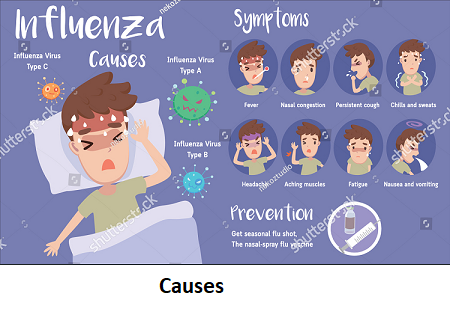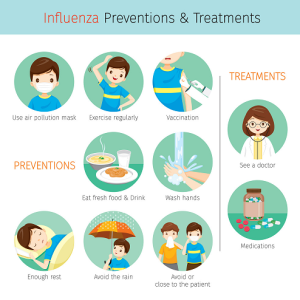Influenza, often referred to as the flu, is an infectious respiratory illness caused by influenza viruses. It has the potential to result in mild to severe illness and, in certain instances, can lead to fatal outcomes. The virus is highly contagious and can be transmitted through activities like talking or physical contact, such as handshakes. Comprehensive understanding of its causes, identification of symptoms, accurate diagnosis, proper treatment, and implementation of necessary precautions are essential steps in effectively managing and preventing the spread of this contagious disease.
Causes;
Influenza A and influenza B are responsible for causing seasonal epidemics in the United States and various other regions every winter. Type C usually causes mild respiratory illness.
Some strains of influenza A, such as the H1N1 “bird flu” virus, occasionally infect humans, causing serious illness. Experts closely monitor these strains, attempting to predict their evolution and anticipate their impact on the population.
These viruses have the potential to undergo mutations over time, resulting in the emergence of new strains, which may reduce the effectiveness of flu vaccines against them. The primary mode of flu transmission is through droplets released when an infected person talks, coughs, or sneezes.

Symptoms of Flu ;
According to the Centers for Disease Control and Prevention (CDC), a person with flu may experience Trusted Source:
a high temperature that lasts 3–4 days
a stuffy or runny nose
cold sweats and shivers
aches that may be severe
a headache
fatigue
Not necessarily all the patients will have all of these symptoms. For instance, flu without a fever is possible.
The symptoms of influenza typically come on suddenly. Initially, a person may experience :Trusted Sour
Trusted Source
- a high temperature
- a stuffy or runny nose
- a dry cough
- cold sweats and shivers
- aches that may be severe
- a headache
- fatigue, and a feeling of being unwell
- a low appetite

Adults with the following symptoms should get medical adviceTrusted Source urgently:
- breathing difficulties
- pain or pressure in the chest or abdomen
- dizziness, confusion, or loss of alertness
- seizures
- not urinating, which may indicate dehydration
- severe pain, weakness, and unsteadiness
- an intermittent fever or cough
- a worsening of other existing health conditions
Children frequently exhibit symptoms similar to those seen in adults, but they may also experience gastrointestinal symptoms such as nausea, vomiting, and diarrhea.
If a child displays the following symptoms, it is crucial to seek emergency medical care:
- breathing difficulties
- rapid breathing
- bluish face or lips
- If a child experiences symptoms such as chest pain or noticeable retractions of the ribs during breathing.
- Severe aches
- Signs of dehydration, such as not urinating for an extended period (e.g., 8 hours) and shedding dry tears, immediate medical attention is essential.
- lack of alertness or interaction with others
- a fever above 104°F or any fever in a child under 12 weeks of age
- a fever or cough that goes away but then comes back
- a worsening of any other medical conditions
Flu can be dangerous for babies If symptoms appear, a parent or caregiver should seek medical help.
A baby may :
- be very tired
- have a cough and sore throat.
- have a stuffy or runny nose
- have a fever of 100°F or more
- have vomiting or diarrhea
Emergency medical attention is imperative for a baby if they experience:
- do not want anyone to hold them
- have a blue or gray skin color
- are breathing fast or have difficulty breathing
- have a fever with a rash
- have symptoms that go away but come back again
- show signs of dehydration, for example, not urinating
- do not wake up or interact
- have severe and persistent vomiting
Diagnosis :
- Rapid influenza diagnostic tests (RIDTs) have the capability to quickly identify the presence of the influenza virus in respiratory samples within minutes.
- Molecular tests like polymerase chain reaction (PCR) offer higher accuracy in identifying the virus and differentiating between strains.
Treatment ;
Healthcare providers may administer antiviral medications under specific circumstances as part of the treatment for certain conditions. Antivirals can reduce your risk of severe illness and shorten the amount of time you’re sick. Many people can treat the it without prescription medications. Providers prescribe antivirals if you:
- Have had symptoms for under 48 hours. The effectiveness of antiviral medications is diminished when initiated more than two days after the onset of symptoms. By this time, the virus has typically undergone significant replication, and the body has initiated its own immune response, fighting off the infection with its antibodies.
- If you have an underlying condition or are at risk for severe illness, healthcare providers may prescribe antiviral medications even if you have been experiencing symptoms for longer than 48 hours.
- Have severe symptoms, even if you’ve been sick for longer than 48 hours.
- If you live with or care for individuals who are at risk for severe complications of the flu, healthcare providers may recommend or prescribe antiviral medications.

Antiviral drugs for influenza include:
- Oseltamivir phosphate (Tamiflu®). You take oseltamivir by mouth as a pill or a liquid. You usually take it for several days.
- Zanamivir (Relenza®). You breathe zanamivir in through your mouth with an inhaler. You usually have to take it for several days. Zanamivir is not advisable for individuals with respiratory conditions such as asthma or COPD.
- Peramivir (Rapivap®). It is administered directly into the veins through an intravenous (IV) injection. Typically, only a single dose of peramivir is required.
Consult your healthcare provider about any health conditions you have before starting an antiviral medication.
Many people can manage their symptoms at home with over-the-counter (OTC) medications and other therapies, including:
- Getting plenty of rest.
- Staying hydrated by consuming fluids like water or broth is recommended to prevent dehydration.
- Applying heat packs or hot water bottles can be beneficial for alleviating muscle aches.
- Taking acetaminophen (Tylenol®) or NSAIDs (Advil®, Motrin®, Aleve®) can help lower your fever and relieve head and body aches.
- Utilizing spray or oral decongestants, such as phenylephrine or pseudoephedrine, can assist in managing a runny or stuffy nose.
- For alleviating a persistent cough, taking cough suppressants (antitussives) like dextromethorphan can be effective.
- Expectorants like guaifenesin can make it easier to clear mucus from the lungs.
Not everyone is suitable for taking specific over-the-counter (OTC) medications, so it is advisable to consult with your healthcare provider before using them. Additionally, it’s a good practice to ensure that certain medications are safe to use together or in conjunction with supplements. Don’t give aspirin to children under the age of 16 unless their provider says it’s okay.
Precautions :
The most effective way to prevent the flu is by receiving the flu vaccine annually. Vaccination trains your immune system to recognize and combat infections before you become ill. Since the influenza virus can mutate each year, necessitating a new vaccine, it is crucial to get vaccinated annually.
Even if you contract a different strain of the flu than the one covered by the vaccine, getting vaccinated can still lower your risk of severe illness. The flu vaccine can be administered as a shot or a nasal spray by your healthcare provider.
Other ways to reduce your risk of getting include:
- Washing your hands frequently with soap and water; if unavailable, using an alcohol-based hand sanitizer.
- Covering your nose and mouth when sneezing or coughing, using your elbow or a tissue instead of your bare hand.
- Avoiding close contact with individuals who are sick with the flu or other infectious diseases.
- Considering wearing a mask if you are sick and cannot avoid being around others.
- Avoiding touching your face, especially your eyes, nose, and mouth.
- Not sharing food or eating utensils (forks, spoons, cups) with others.
Frequently Asked Questions (FAQs);
What is the flu?
The flu, short for influenza, is a contagious respiratory illness caused by influenza viruses. It can range from mild to severe, and in some cases, even be fatal.
What are the symptoms of the flu?
Fever, cough, sore throat, runny or stuffy nose, muscle aches, fatigue, headache, and chills are common symptoms. They usually come on suddenly and can last for 7-10 days.
How does the flu spread?
The flu spreads through respiratory droplets when an infected person coughs, sneezes, or talks. You can also get it by touching a contaminated surface and then touching your eyes, nose, or mouth.
How can I prevent the flu?
The best way to prevent the flu is to get vaccinated every year. You can also help prevent it by washing your hands frequently, avoiding close contact with sick people, and covering your mouth and nose when you cough or sneeze.
How is the flu diagnosed?
Your doctor may diagnose the flu based on your symptoms and a rapid influenza diagnostic test.
How is the flu treated?
There is no specific cure for the flu, but antiviral medications can help shorten the duration and severity of illness. Rest, fluids, and over-the-counter medications can also help relieve symptoms.
When should I see a doctor for the flu?
See a doctor if you have severe symptoms, are at high risk for complications (e.g., pregnant women, young children, older adults, people with chronic health conditions), or your symptoms worsen or don't improve after a few days.
What is the difference between the flu and a cold?
Both can cause similar symptoms, but the flu typically comes on more suddenly and is more severe. Colds are also more likely to cause a runny nose and congestion, while the flu often causes fever and muscle aches.
What are the complications of the flu?
While most people recover without complications, the flu can lead to pneumonia, ear infections, sinus infections, and even death in some cases.






